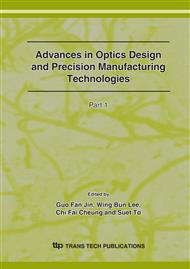p.584
p.590
p.595
p.601
p.607
p.613
p.618
p.624
p.629
Fabrication of Large-Area Imprint Mold with High-Aspect-Ratio Nanotip Arrays of Sub-Micron Diameter
Abstract:
Many research works have been focusing on nanoimprint technology due to the recent potential mass production for the nanostructure applications. For optical or display application, a nanoimprint mold of large area becomes one of the thorniest techniques since it takes much time to fabricate the whole mold with nanostructure and it may make the beginning nanostructures inconsistent with the final ones. In order to fabricate the nanostructure mold of large area in a short time, the plasma process forming nanostructures on silicon substrate and the electroforming process are explored in the current study. Well-aligned nanotip arrays of 4 inch silicon were fabricated by electron cyclotron resonance (ECR) plasma process using gas mixtures of silane, methane, argon, and hydrogen. The resultant tips have nano-scale apexes, approximately ~1 nm, with high aspect ratios, nearly ~15, which were achieved by simultaneous SiC nano-mask formation and dry etching during ECR plasma process. Next, the nickel mold of nanostructures is made from silicon nanostructures through the electroforming process by using Nickel Sulfamate. The total thickness of the nickel mold is 120 μm after a 10-hour-long electroforming process. The nanostructures of 100 nm diameter holes are successfully obtained. Nanoimprint process is proceeded by the nickel mold and the reflectance of the PMMA after imprinting at 160 °C has the lowest value, 0.2 %, compared with the other results for the incident optical wavelength of 550 nm. The large-area imprint mold with high-aspect-ratio nanotip arrays of sub-micron diameter is fabricated and is proofed by the optical application.
Info:
Periodical:
Pages:
607-612
Citation:
Online since:
December 2007
Authors:
Keywords:
Price:
Сopyright:
© 2008 Trans Tech Publications Ltd. All Rights Reserved
Share:
Citation:


